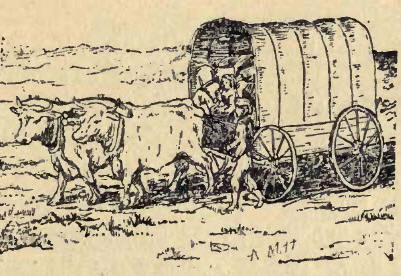|
THE CLOTHING OF THE PEOPLE—THE FASHIONS IN DRESS—OUR
GRANDMOTHERS' WHITE CAPS.
BROADCLOTH was not unknown
in the early days, but the wearing of such
clothing was restricted to weddings and
special holiday occasions, the ordinary clothing of the people being made
from what was called "homespun." The woo] was
carded, dyed, and spun by the good housewife or some of the female members
of the family, and in many cases woven by them or by some neighbor who had
a loom, after which it was fulled to prevent it from shrinking. An
itinerant tailor, when he could be had, was engaged to come to the house
to mend and make up clothing for the whole family. Stockings in abundance
were knit for the family by the old grandmother or aunt, etc. Many of us,
brought up in such households, can imagine we hear the click of her
needles or see the elderly dame glancing over the top of her spectacles to
observe what was going on, or to make some necessary remark.
A favorite cloth for women's dresses was the "linseywoolsey,"
a mixture of linen and woolen. It made a very pretty dress, the cloth
being woven in stripes of several colors. The yarn was colored previous to
weaving, our grandmothers keeping a special tub for this purpose. The dyes
used were most of them homemade. Indigo was used for dying blue, madder
for red, butternut husks or sumach blossoms for brown, onion skins, wax-
wood or golden rod for yellow and beech tree bark for drab.
The Fashions in Dress.
The fashions in dress in the early days were many and
diverse, many of the religious denominations having a style of dress
peculiar to themselves. Some of them dressed very plainly, it being
considered an indication of pride to dress at all gaudy. As at present,
the styles varied from time to time; certain innovations and changes in
style coming in and going out, changing with the seasons of the year. In
the first half of the century the prevailing style of dress coat was the
frock coat, similar in appearance to the present Prince Albert, but
longer. The large and roomy box-coat, with big pockets in the sides and
brass and horn buttons, so common in the eighteenth century, was worn by
some of the older. men. Later on came the cutaway, now called the morning
coat. Among the Mennonites and Tunkers many wore the
swallow-tail or shad-belly coat, similar in shape to the present full
dress coat, only the collars were straight, i.e., made to stand up instead
of to lie down. At the beginning of the century, among the English people,
and the New Englanders, knee breeches and long stockings were worn by the
men, but we have no knowledge that this custom prevailed in Canada to any
great extent, trousers or pantaloons being the style. The old English
style must have been in vogue in Canada amongst certain classes for a time
at least after the Revolutionary War, for Mr. Kirby, in his "Annals of
Niagara," in describing the meeting of the first Parliament of Upper
Canada, in 1792, says that at that gathering "the people were in their
best holiday attire. The men, in the fashion of the times, in long
stockings, garters and shoes, with their hair in queues, surmounted by
three-cornered hats; the women in dresses high-waisted, with tight sleeves
and bunched up behind over elaborate petticoats." Among the women there
was to be seen at various times the poke bonnet, the cottage bonnet, the
Quaker scoop and numerous other styles of head-dress, the more stylish
ones being made of beaver, Leghorn or straw. They did their hair up in
plaits, waterfalls, curls, or in a coil behind, but with no bangs. Hoops
held sway for quite a time, but even they were more sensible than the
modern corset, which gives shape and figure to a woman at the expense of
health, for, no doubt, they are the cause of much of the headaches and
other diseases, as well as premature deaths, so unhappily prevalent among
the ladies.* The plug or silk hat (at one time made of beaver skin with
the fur side out) has always, with its many changes in shape, been more or
less fashionable among professional men, not excepting the old time dandy
or the young man who wished to cut a dash among the ladies.
Our Grandmothers' White Caps.
It was the custom in the early
days for all the old women to wear white caps. Among certain religious
denominations, such as the Mennonites, Tunkers and Quakers, even the young
women, as soon as they were enrolled as members, were obliged to comply
with the rules of the society and don the conventional white cap. White
caps were worn night and day, only the night cap, worn while sleeping,
being plainer than that worn in the daytime. These caps, no doubt, may
have detracted from the beauty of the wearer somewhat, yet for all that,
the women looked well in their quaint attire. They always kept themselves
so prim and nice, great pains being taken in ironing and starching the
frills on the borders of their caps, and the strings or ribbons that fell
down the fair rosy cheeks and were tied in a bow knot underneath the chin.
We have handed down to us from the times of our grandmothers odd-shaped
irons for ironing and fixing these frills, and mangles (made something
like wringers with wooden rollers) for smoothing the caps.

|

